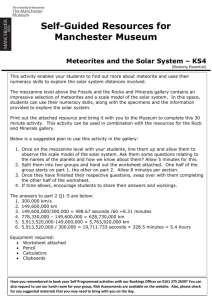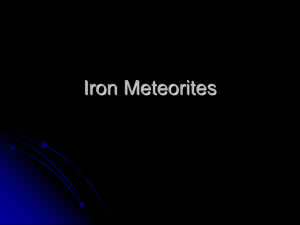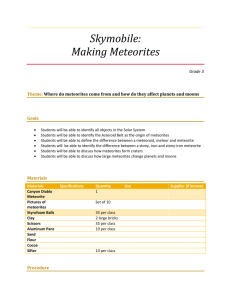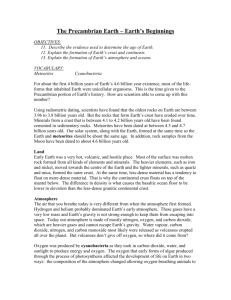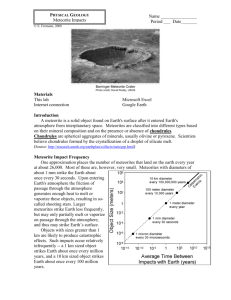Luanne Meteorites - Natural History Museum
advertisement
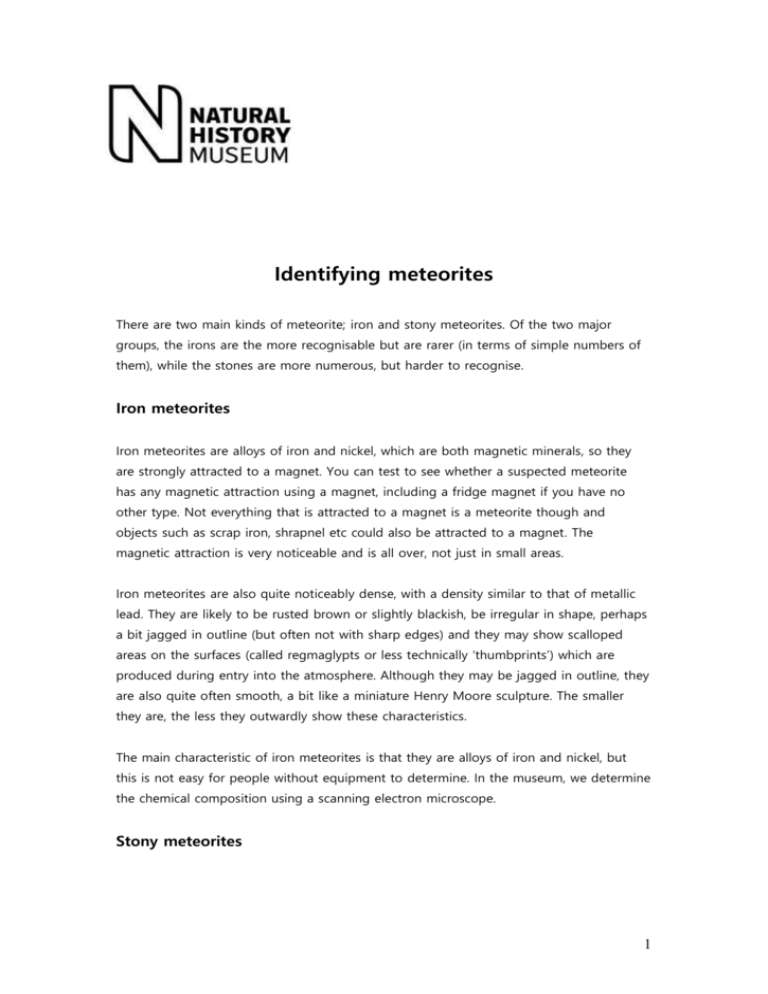
Identifying meteorites There are two main kinds of meteorite; iron and stony meteorites. Of the two major groups, the irons are the more recognisable but are rarer (in terms of simple numbers of them), while the stones are more numerous, but harder to recognise. Iron meteorites Iron meteorites are alloys of iron and nickel, which are both magnetic minerals, so they are strongly attracted to a magnet. You can test to see whether a suspected meteorite has any magnetic attraction using a magnet, including a fridge magnet if you have no other type. Not everything that is attracted to a magnet is a meteorite though and objects such as scrap iron, shrapnel etc could also be attracted to a magnet. The magnetic attraction is very noticeable and is all over, not just in small areas. Iron meteorites are also quite noticeably dense, with a density similar to that of metallic lead. They are likely to be rusted brown or slightly blackish, be irregular in shape, perhaps a bit jagged in outline (but often not with sharp edges) and they may show scalloped areas on the surfaces (called regmaglypts or less technically ‘thumbprints’) which are produced during entry into the atmosphere. Although they may be jagged in outline, they are also quite often smooth, a bit like a miniature Henry Moore sculpture. The smaller they are, the less they outwardly show these characteristics. The main characteristic of iron meteorites is that they are alloys of iron and nickel, but this is not easy for people without equipment to determine. In the museum, we determine the chemical composition using a scanning electron microscope. Stony meteorites 1 Stony meteorites are more difficult to recognise. They are, after all, silicate rocks and thus do not differ much from silicate rocks on earth, other than being rather more primitive. The main characteristic of stony meteorites is that they have a black, vitreous (glassy), fusion crust on outer surfaces. In space meteorites have no source of heat and are extremely cold, at a temperature approaching absolute zero. They enter the atmosphere at high velocity and with friction heat up to a red heat. This melts the outer surface but only to a depth of about 1mm or so, which then sloughs off and burns away, to replaced by a bit more melted material. This continues until the stone loses velocity and slows down, whereupon it falls to earth. The descent is quite rapid, and the cooling also rapid, so the molten outer layer does not have time to crystalise, and solidifies as a glass (glasses are really very viscous (stiff) liquids with no crystal structure). It is hard to reproduce this crust in any other way. Since the stones are more ‘shocked’ than the irons they tend to break up more under stresses during entry to earth’s atmosphere, and so any found item is likely to be a portion, and only show a fusion crust on a small part of its surface (occasionally of course it might break in such a way that there is no crust shown). It is easy to confuse this crust with a specimen which is black all through, but stony meteorites are generally light coloured inside. Due to this melting they also tend to be smooth on the surface, as a sharp edge would be the first thing to melt under the intense heating during entry into the atmosphere. Again, this may not be apparent if you only have a bit of surface remaining. They are about the same density as terrestrial rocks. The other main characteristic for most stony metoeirtes (with some exceptions), is that they contain rounded, spherical globules known as chondrules, which are silicate mineral blobs formed in space. As these formed in space they are spherical as that is the only shape that can form in zero gravity. These may not be visible except under some magnification, and then only on a cut surface. Stony meteorites also generally (again there are a few exceptions) show a weak attraction to a magnet, as they usually contain some free metal (iron). If there is no attraction it is unlikely to be a meteorite, especially if it also has none of the other characteristics. Meteorite falls The trajectory of a meteorite is quite simple, and is rather similar to a bomb released from an aircraft (although starting at a much higher level) which has a large component of horizontal travel until it gradually starts to drop vertically. It enters the atmosphere and is heated up. It might break up under the stresses and strains, and small pieces will probably burn away completely. The remainder, if it isn’t destroyed, continues to fall losing speed, and gradually assumes a vertical fall eventually dictated by the pull of gravity. On earth we may see this entry as a fireball in the sky. Any debris from a fireball 2 will fall maybe 30 -50 miles away, so when people claim they saw a fireball and then saw an object fall nearby, or found the suspected meteorite later, we know the two events are not related. Meteor-wrongs Meteorites are most likely to be confused with industrial waste products known as slag. Slag is the the mixture of waste compounds that is removed from ore by metal smelting to produce pure metal. Many slags do show a faint (and sometimes quite strong) magnetic attraction, but this is often only in certain places on the specimen, but in a meteorite the iron is equally distributed so it is attracted to a magnet all over. Some slags are also black, but this is an inherent colour, and not a thin coating. Slags also are often jagged, but meteorites, especially stony meteorites, are generally quite smooth as small points are the first places to melt. Slags often contain cavities caused by gas bubbles, a bit like an Aero bar. Few natural rocks have so many gas bubble cavities, except for some of volcanic origin, like lavas, and pumice. Meteorites do not show gas-bubble cavities, as any such cavity, if filled with gas at the time of entry into the atmosphere, would expand and break the specimen apart. The thin edges of the cavity would then melt first and be ablated to leave a smooth surface. Slag has been used extensively to build walls, fill in roads and paths and as ballast to weigh down ships, and has also often been dumped. For these reasons it is found in parks, gardens, fields and on beachs, often far from recognised industrial areas. Terrestrial rocks of many sorts are also mistaken for meteorites. It is often easier to tell you that your specimen is not a meteorite than to identify exactly wat rock type it is. Many rocks are not easily identified without cutting a thin section, which is a section cut and mounted on a glass slide, and then ground down until it is thin enough for light to pass through (it is about the thickness of a human hair). This is followed by microscopic examination to determine the type and rough (or exact) percentage of crystals present, from which a name can be derived. Cutting a section is a labour and time intensive process, and we cannot offer it for routine enquiries. UK Meteorites Meteorites are extremely rare finds in the UK. There have only been about 25 meteorites ever found in the UK,.The last meteorite to fall and be found in the UK was the Glatton meteorite (near Peterborough), which fell in 1991. Other notable UK discoveries are one of the largest UK falls in 1965 in Barwell, Leicestershire, when a whole series of stones fell 3 over an oval area of several kilometres in extent. Another large stone fell in the 18th century at Wold Cottage in Yorkshire and was recovered. Very few meteorites are found by chance; meteorites are generally discovered by experts searching for them, particularly in deserts and arctic regions. These areas have two advantages over the UK. Firstly, they are dry and so meteorites preserve better. Most meteorites contain iron to some extent and so decompose quite rapidly in a wet climate like the UK. Secondly, these areas have less vegetation and other rocks that make meteorites harder to distinguish. You can find out more about meteorite hunters at our blog: http://www.nhm.ac.uk/natureplus/blogs/meteorites Further information Beyond these pointers, it is just a question of looking at images of them and getting an overall picture in your mind. Here are some websties and books that I recommend: http://www.nhm.ac.uk/nature-online/space/meteorites-dust/index.html http://www.nhm.ac.uk/nature-online/virtual-wonders/index3.html http://epswww.unm.edu/iom/ident/index.html http://www.meteorites.com.au/found.html http://www.aerolite.org/found-a-meteorite.htm Meteorites. (2009) Smith, C., Russell, S. and Benedix, G. Natural History Museum. Meteorites: Their Impact on Science and History. (2001) Ed. Zanda, B., and Rotaru, M. Cambridge University Press. Rocks from Space. (1998, 2nd ed.) Norton, O. R., Mountain Press Publishing Company. The Cambridge Encyclopedia of Meteorites. (2002) Norton, R. O., Cambridge University Press Luanne Faulknall, Earth Sciences Advisor Identification and Advisory Service Call: 020 7942 5045 Email: ias2@nhm.ac.uk Visit our forum: http://www.nhm.ac.uk/natureplus/community/identification 4

